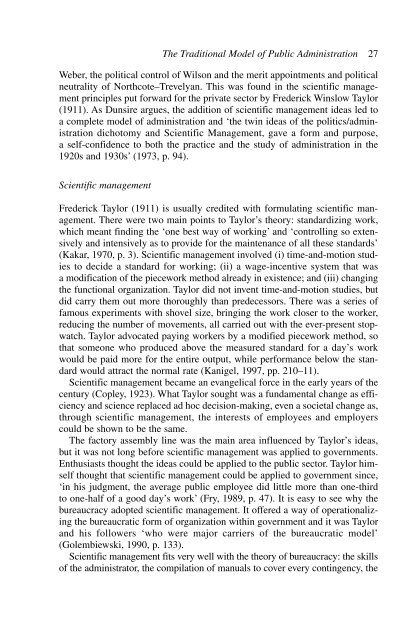Public Management and Administration - Owen E.hughes
Public Management and Administration - Owen E.hughes
Public Management and Administration - Owen E.hughes
Create successful ePaper yourself
Turn your PDF publications into a flip-book with our unique Google optimized e-Paper software.
Weber, the political control of Wilson <strong>and</strong> the merit appointments <strong>and</strong> political<br />
neutrality of Northcote–Trevelyan. This was found in the scientific management<br />
principles put forward for the private sector by Frederick Winslow Taylor<br />
(1911). As Dunsire argues, the addition of scientific management ideas led to<br />
a complete model of administration <strong>and</strong> ‘the twin ideas of the politics/administration<br />
dichotomy <strong>and</strong> Scientific <strong>Management</strong>, gave a form <strong>and</strong> purpose,<br />
a self-confidence to both the practice <strong>and</strong> the study of administration in the<br />
1920s <strong>and</strong> 1930s’ (1973, p. 94).<br />
Scientific management<br />
The Traditional Model of <strong>Public</strong> <strong>Administration</strong> 27<br />
Frederick Taylor (1911) is usually credited with formulating scientific management.<br />
There were two main points to Taylor’s theory: st<strong>and</strong>ardizing work,<br />
which meant finding the ‘one best way of working’ <strong>and</strong> ‘controlling so extensively<br />
<strong>and</strong> intensively as to provide for the maintenance of all these st<strong>and</strong>ards’<br />
(Kakar, 1970, p. 3). Scientific management involved (i) time-<strong>and</strong>-motion studies<br />
to decide a st<strong>and</strong>ard for working; (ii) a wage-incentive system that was<br />
a modification of the piecework method already in existence; <strong>and</strong> (iii) changing<br />
the functional organization. Taylor did not invent time-<strong>and</strong>-motion studies, but<br />
did carry them out more thoroughly than predecessors. There was a series of<br />
famous experiments with shovel size, bringing the work closer to the worker,<br />
reducing the number of movements, all carried out with the ever-present stopwatch.<br />
Taylor advocated paying workers by a modified piecework method, so<br />
that someone who produced above the measured st<strong>and</strong>ard for a day’s work<br />
would be paid more for the entire output, while performance below the st<strong>and</strong>ard<br />
would attract the normal rate (Kanigel, 1997, pp. 210–11).<br />
Scientific management became an evangelical force in the early years of the<br />
century (Copley, 1923). What Taylor sought was a fundamental change as efficiency<br />
<strong>and</strong> science replaced ad hoc decision-making, even a societal change as,<br />
through scientific management, the interests of employees <strong>and</strong> employers<br />
could be shown to be the same.<br />
The factory assembly line was the main area influenced by Taylor’s ideas,<br />
but it was not long before scientific management was applied to governments.<br />
Enthusiasts thought the ideas could be applied to the public sector. Taylor himself<br />
thought that scientific management could be applied to government since,<br />
‘in his judgment, the average public employee did little more than one-third<br />
to one-half of a good day’s work’ (Fry, 1989, p. 47). It is easy to see why the<br />
bureaucracy adopted scientific management. It offered a way of operationalizing<br />
the bureaucratic form of organization within government <strong>and</strong> it was Taylor<br />
<strong>and</strong> his followers ‘who were major carriers of the bureaucratic model’<br />
(Golembiewski, 1990, p. 133).<br />
Scientific management fits very well with the theory of bureaucracy: the skills<br />
of the administrator, the compilation of manuals to cover every contingency, the











